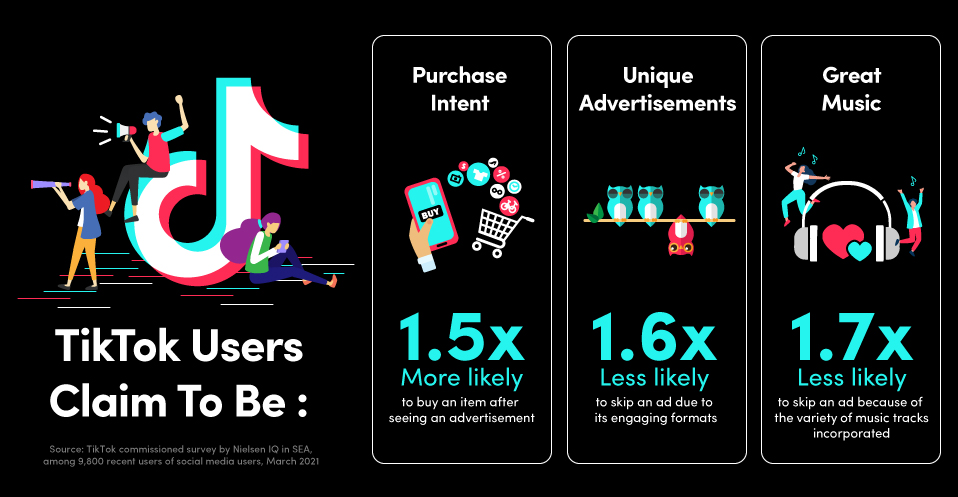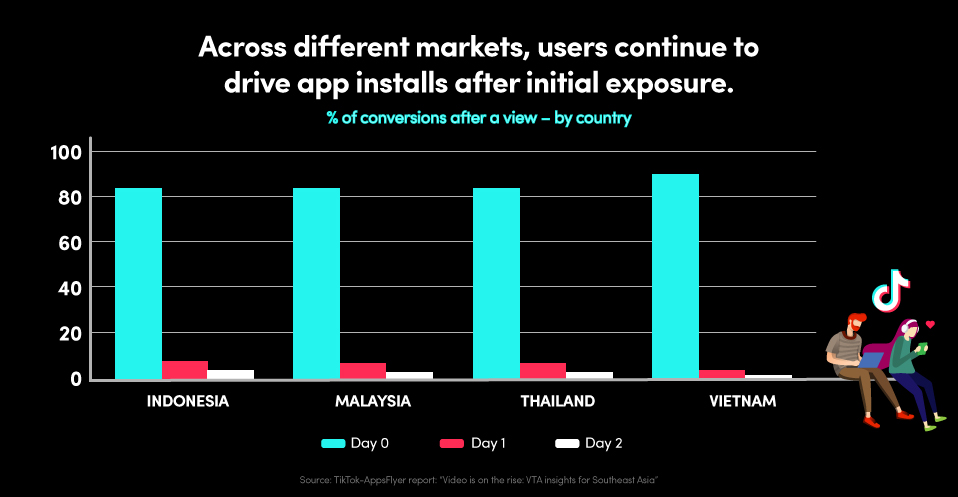Realizing the True Value of a View

Realizing the True Value of a View
26 August 2021
TikTok For Business
PerspectivesInsightsBest Practices
Knowing how much sales you’ve driven through a campaign is important. But knowing where and how those sales were driven is exponentially more impactful for optimizing your campaigns to achieve your business goals. These same principles also apply to tracking the performance of your TikTok ad campaigns.
As marketers, we’re partial to knowing exactly how much return we’re getting back for every ad dollar spent. So with an ad attribution model like Click-Through Attribution (CTA), it should be a catch-all solution, right?
After all, clicks are often seen to best represent purchase intent and carry more weight than views as clicks directly measure the impact of each ad. But, tracking only for clicks may not give the full picture you need to optimize campaign performance since there are times consumers might just view an ad now and visit the landing page or app later. Thus, it's important to understand how to incorporate clicks with views in measurement to capture the true customer journey and drive downstream benefits.
Why Click-Through Attribution Isn't Enough
Don't get us wrong. A CTA model is great for driving and tracking app installs. After all, it measures last-click conversions. However, CTA alone might paint an inaccurate picture for industries that traditionally have long attribution windows. Or products that wouldn't normally be impulse purchases.
The travel industry is a prime example. Customers often browse several sites and compare prices of a plane ticket. When they feel that they’ve found the best value, that's when they'll buy the ticket. But if you're tracking this customer journey on a CTA model, you'd be inclined to think that some of your first-touch ads aren't resonating. You might not see a high volume of clicks right away. After all, would you purchase a plane ticket on the spot after viewing the ad for the first time? Marketers in this situation might easily come to the assumption or conclusion that the campaign is a dud. In reality, higher priced products call for longer attribution windows. This includes financial products and white goods.
In fact, the customer decision cycle on a video-first platform like TikTok is more dynamic as video ads are more engaging than static ones. And users tend to spend more time consuming short-form video content on TikTok than on other platforms. According to the AppsFlyer-TikTokVideo on the Rise: View-Through Attribution Insights for Southeast Asiareport, the Southeast Asia session duration reaches as much as 389 seconds for users! That's 1.9X longer than the next longest used social platform.
So even though only 14% of users will click on a link in a TikTok ad right away, they're just much more engaged on TikTok. What this means for brands is that users have likely consumed more content about your brand on the platform, and often end up coming back to the brand site later.

Let's take another example: the first interaction or awareness about a financial app from a TikTok ad. In all likelihood, the ad would compel interested customers to compare financial services through a Google search. Now assume the best value is offered by the financial services app that advertised on TikTok. The customer would simply visit the brand's own site and sign up directly. But that download and registration wouldn't have directly happened again on TikTok.
In other words, the attribution wouldn’t have been instant. And in this case, tracking sales on a CTA basis would have steered any marketer toward the wrong conclusion. According to a survey by research firm Toluna, 58% of TikTok users in Southeast Asia delayed visits to brand website or app rather than disrupt their content browsing. Hence, the advertising on TikTok might see lower clicks here than expected. But dig deeper and they may actually be driving a higher volume of sales because of TikTok. Imagine if you'd decided to turn off your TikTok ad campaigns, only for sales to suddenly plummet.
Measure beyond last-click behavior with View-Through Attribution
While the CTA model remains a heavy favorite among advertisers, it isn't ideal for those that buy into video ad inventory. For most brands, the CTA model combined with the View-Through Attribution (VTA) model offers a clearer understanding of just how your campaign is performing. More importantly, it lets you optimize your spend for marketing effectiveness and efficiency.
The VTA model measures the sales driven within an attribution window, which on average in Southeast Asia is just over 24-hours. As we'd seen with the example of the financial services app, a VTA + CTA model would tell advertisers a clearer or more accurate story. With the longer attribution window, it gives you enough time to account for the full customer journey, including returning to your site to convert.
Why a Hybrid Solution Works Best
Currently VTA adoption in Southeast Asia is trailing the CTA model. And we see this consistently across sectors. However, this may soon change. 40% of all programmatic ads bought in Southeast Asia is dedicated to video. Not to mention, budgets allocated to video are rapidly rising.
And this is contributing to a more complex customer journey. From the first view, down to the sale, customers are exposed to the brand through multiple touchpoints before converting. And we know that tracking this on a CTA basis isn't recommended. While there might not be a one-size-fits-all solution for measuring all campaigns, advertisers stand to benefit from a combination of tracking for both CTA and VTA.
Immersive Videos Drive Higher Intent
As video adoption accelerates, the video ads themselves have become more immersive. The more engaging the ad becomes, the more likely users won’t act on the ad immediately. Think of it this way: they might not want to interrupt the ad by clicking through in preference for watching it fully. Yet, based on data from NielsenIQ, viewers are still 1.5x more likely to buy a product after seeing an ad on TikTok.
Downstream Impact of VTA on TikTok campaigns
The added benefit of running a VTA + CTA model for your TikTok campaign is two-fold. The campaign learning period is accelerated, where campaigns in verticals such as ecommerce, media & entertainment, and finance optimise up to 113% faster with a VTA + CTA model. This is in addition to having a lower fluctuation on ad spend, thus increasing performance stability.
Getting a Bargain
With the combined model, you're likely getting more than what you've paid for. Based on TikTok data, users will download an app or convert even the days following the first time they've viewed the ad. In fact, consistently across markets throughout Southeast Asia, ad campaigns will achieve between 80% and 90% of the conversions on the first day. But you'll still see a pretty significant 10% to 20% of the total conversions come through on Day 1 and Day 2.

Seeing the Bigger Picture with VTA
For many brands, advertisers won't go wrong with a hybrid model tracking on both a VTA and CTA basis. In fact, the data speaks for itself. Compiled in collaboration with AppsFlyer, ourVideo is on the Rise: View-Through Attribution Insights for Southeast Asiareport puts numbers to the claims. This data is based on 14K apps, 10B installs, 1 trillion app opens, 6B remarketing conversions, and 35M pre-installs. If there's a comprehensive report on why using VTA + CTA for your campaign is optimal to your strategy, this report is it.
Now, if you're convinced and wondering how to find a VTA + CTA model that works for your brand, you can check out our next blog post in this series: How to Make View-Through Attribution Work For Your Business.
